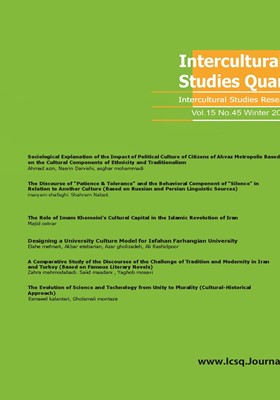Designing a University Culture Model for Isfahan Farhangian University
Subject Areas : INTERCULTURAL STUDIES QUARTERLY
elahe mehnati
1
,
akbar etebarian
2
,
azar gholizadeh
3
,
Ali Rashidpoor
4
![]()
1 - department of Cultural Affairs Management, Isfahan (Khorasgan) Branch , Islamic Azad University, Isfahan, Iran.
2 - Associate Professor Department of Cultural Affairs Management, Isfahan (Khorasgan) Branch, Islamic Azad University, Isfahan, Iran
3 - Associate Professor Department of Cultural Affairs Management, Isfahan (Khorasgan) Branch, Islamic Azad University, Isfahan, Iran.
4 - Associate Professor Department of Cultural Affairs Management, Isfahan (Khorasgan) Branch, Islamic Azad University, Isfahan, Iran.
Keywords: culture, University, Farhangian University, Academic Culture,
Abstract :
This research, which was carried out with the aim of designing a university culture model in Farhangian University, is a type of consecutive mixed research that was conducted in two parts: qualitative and quantitative. In the qualitative section, the phenomenological method was used and with 16 faculty members of Isfahan Farhangian University who were selected by snowball method, the interview was conducted until complete saturation and the dimensions and components of university culture were coded and specified and turned into a questionnaire. Quantitative research, which is descriptive research type was conducted by survey method. The designed questionnaire was distributed among 351 students who were identified by available classification sampling method and through construct validity and confirmatory factor analysis in LISREL software environment, the correspondence between components and dimensions of university culture in Farhangian University was examined and finally the culture model. Farhangian University University was approved in 7 dimensions of national and religious identity, cultural values, promotion of research values, promotion of educational values, cultural activities, strengthening of material culture and academic norms with 25 sub-concepts.
آقابابایی فیشانی، ی ( ۱۳۹۸). ارائه الگوی تولید منابع درسی مطابق با فرهنگ تولید علم در دانشگاههای غیرانتفاعی کشور، یونس، رسالهی دکتری دانشگاه عدالت.
دهقانی زاده، مرضیه، زینآبادی، حسن رضا، آراسته ،حمیدرضا، نوه ابراهیم ،عبدالرحیم (1397). طراحی و تبیین الگوی پیشایندهای فضیلت سازمانی در دانشگاههای دولتی یزد، مجلهی توسعه و آموزش پزشکی (303-284).
فدایی، صمد، نیاز آذری، کیومرث، تقوایی یزدی ،مریم (1396). ارائه مدلی برای ایجاد دانشگاه کارآفرین مبتنی بر تکنیکهای آینده نگاری و تولید علم در نظام آموزشی، دورهی 8، شمارهی 32، 1-18.
قاسمی، افسانه (۱۳۹۸). تجربه زیسته و ادراکشده دانشجویان از فرهنگ دانشگاهی (تحصیلات تکمیلی گروه علوم انسانی دانشگاههای تهران)، جامعهشناسی نهادهای اجتماعی دورهی ششم بهار و تابستان ۱۳۹۸ شمارهی۱۳، 95 – 126.
محمدی بابازیدی، سلمان، عباسپور، عباس، سلیمان، حمید، غیاثی، سعید (1399). رویکرد خلاقانه در طراحی سازمان دانشگاه، نشریهی علمی ابتکار و خلاقیت در علوم انسانی (54-35)ُ.
هوشی السادات، علیرضا، رحیمیان، حمید، عباس پور، عباس، خورسندی، علی و غیاثی، سعید (1397).طراحی الگوی ناب برای دانشگاه فرهنگیان، ماهنامهی علمی پژوهشی راهبردهای آموزش در علوم پزشکی.
Basir. S.A, Davies. J,J Douglas.J & Douglas. A (2017). The influence of academic culture on quality management system ISO 9001 maintenance within Malaysian universities, Journal of Higher Education Policy and Management, Volume 39, 2017 - Issue 3
Becher, T(1981) Towards a definition of disdplinary culture' Studies in Higher Education 6, 109-122.
Bergquist, W.H (1992) The Four Cultures of the Acodemy: Insights and strategies for improing Leadership in Collegiate Organizations. San Francisco: Jomey-Bam.
Bourdieu, Pierre (1986). The forms of capital, Hand book of theory & research for the sociology of education by john, G.richardson, greenwood press
Clark, B.IL (1972) The organizational saga in higher education.' Administrative science, Quarterly 17, 178-183.
Cooke,R. A & D.M. Rousseau (1988). Behavioral Norms and Expectations: A Qualitative Approach to the Assessment of Organizational Culture. Group & Organizational Studies. 13. 245-273.
Denison, D (1990). CorporateCulture: Organizational Effectiveness. New York.JohnWiley & Sons
Dill, D.D (1982). The management of academic culture, notes on the management of meaning and social integration. In Higher Education 11, 303-320.
Galtung, J. (1981). Structure, culture and intellectual style: and essay comparing Saxonic, Teutonic, Gallic and Hipponic approaches, Social Science Information 20, 6:817-56.
Hellrigel, D. & J. Slocum (1996). Management. PWS.
Payton J, Jamika D. Burge J D, Denner J (2019). The Reality of Inclusion: The Role of Relationships, Identity, and Academic Culture in Inclusive and Equitable Practices for Broadening Participation in Computing Education, SIGCSE '19: Proceedings of the 50th ACM Technical Symposium on Computer Science Education, 494–495 https://doi.org/10.1145/3287324.3287337.
Purwana D ( 2015). The Effect of Transformational Leadership, Academic Culture and Organizational Health on Managerial Effectiveness: A Study of An Indonesian Public Higher Education Institution, e Business and Economics Research, Vol. 4, no. 4,.367-380.
Quinn, Robert E (1999). “Diagnosing culture and changing organizational culture, “Newyork: Addison Wesley.
Riesman D. and Jencks C. )1963(. The Viability of the American College. -In N. Sanford (ed.) The American college. A psychological and social interpretation of the higher learning. New York: Wiley, pp. 74–192.
Tierney' W.G (1988). 'Organizational culture in higher education. Defining the essentials.'Journal of Higher Education 59, 2-21.
Upadyaya, Katja., Vartiainen, Matti and Salmela-Aro, Katariina (2016). From job demands and resources to work engagement, burnout, life satisfaction, depressive symptoms, and occupational health. Burnout Research 3. (2016,) 101– 108.
Valima , j(1998). Culture and Identityin Higher Education Research, Higher Education,36,2:119-138.
_||_

